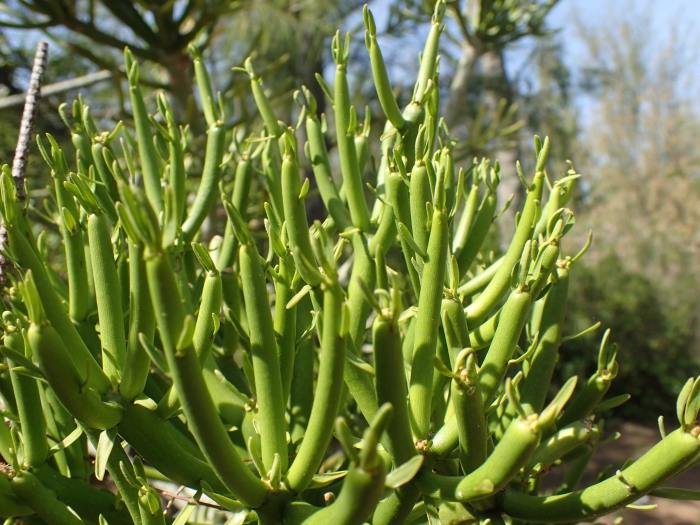Indiantree Spurge
(Euphorbia tirucalli)
Indiantree Spurge (Euphorbia tirucalli)
/
/

Martin Purdy
CC BY 4.0
Image By:
Martin Purdy
Recorded By:
Copyright:
CC BY 4.0
Copyright Notice:
Photo by: Martin Purdy | License Type: CC BY 4.0 | License URL: http://creativecommons.org/licenses/by/4.0/ | Rights Holder: Martin Purdy | Publisher: iNaturalist | Date Created: 2017-10-23T15:36:13-07:00 |






















































Estimated Native Range
Summary
Euphorbia tirucalli, commonly known as Indiantree Spurge or Pencil Tree, is an evergreen succulent native to semi-arid tropical climates including savannahs and dry forests in Africa, Madagascar, the Arabian Peninsula, India, and Sri Lanka. It can grow as a shrub or small tree, typically reaching up to 7 meters in height, with distinctive pencil-thick, green, smooth branches. The plant’s form is characterized by a cylindrical and fleshy stem with fragile, succulent twigs that are about 7 mm thick, often produced in whorls and finely striated. The small, oval leaves are ephemeral, usually dropping early in the season. Euphorbia tirucalli is known for its milky, toxic, and corrosive sap, which can cause skin and eye irritation.
In cultivation, Indiantree Spurge is valued for its unique architectural form and is often used in xeriscaping, rock gardens, and as a container plant in areas where it is not invasive. It requires minimal maintenance, thriving in full sun and well-drained soils, and is drought-tolerant once established. However, gardeners should handle it with care due to its toxic sap and wear protective clothing. It is potentially invasive in some regions, such as Florida and parts of Central and South America, and should not be planted where it can escape cultivation.CC BY-SA 4.0
In cultivation, Indiantree Spurge is valued for its unique architectural form and is often used in xeriscaping, rock gardens, and as a container plant in areas where it is not invasive. It requires minimal maintenance, thriving in full sun and well-drained soils, and is drought-tolerant once established. However, gardeners should handle it with care due to its toxic sap and wear protective clothing. It is potentially invasive in some regions, such as Florida and parts of Central and South America, and should not be planted where it can escape cultivation.CC BY-SA 4.0
Plant Description
- Plant Type: Tree, Shrub
- Height: 20-30 feet
- Width: 6-10 feet
- Growth Rate: Slow
- Flower Color: N/A
- Flowering Season: Spring, Summer
- Leaf Retention: Evergreen
Growth Requirements
- Sun: Full Sun
- Water: Low
- Drainage: Medium, Fast
Common Uses
Deer Resistant, Drought Tolerant, Low Maintenance, Potted Plant, Rabbit Resistant
Natural Habitat
Semi-arid tropical climates including savannahs and dry forests in Africa, Madagascar, the Arabian Peninsula, India, and Sri Lanka
Other Names
Common Names: African Milkbush, Indian Tree Spurge, Rubber Euphorbia, Naked-Lady, Milkbush, Milkhedge, Penciltree, Pencil Cactus, Petroleum-Plant, Fingertree
Scientific Names: , Euphorbia tirucalli, Euphorbia laro, Euphorbia rhipsaloides, Euphorbia scoparia, Euphorbia media, Euphorbia tirucalli var. rhipsaloides, Arthrothamnus tirucalli, Euphorbia geayi, Euphorbia media subsp. bagshawei
GBIF Accepted Name: Euphorbia tirucalli L.